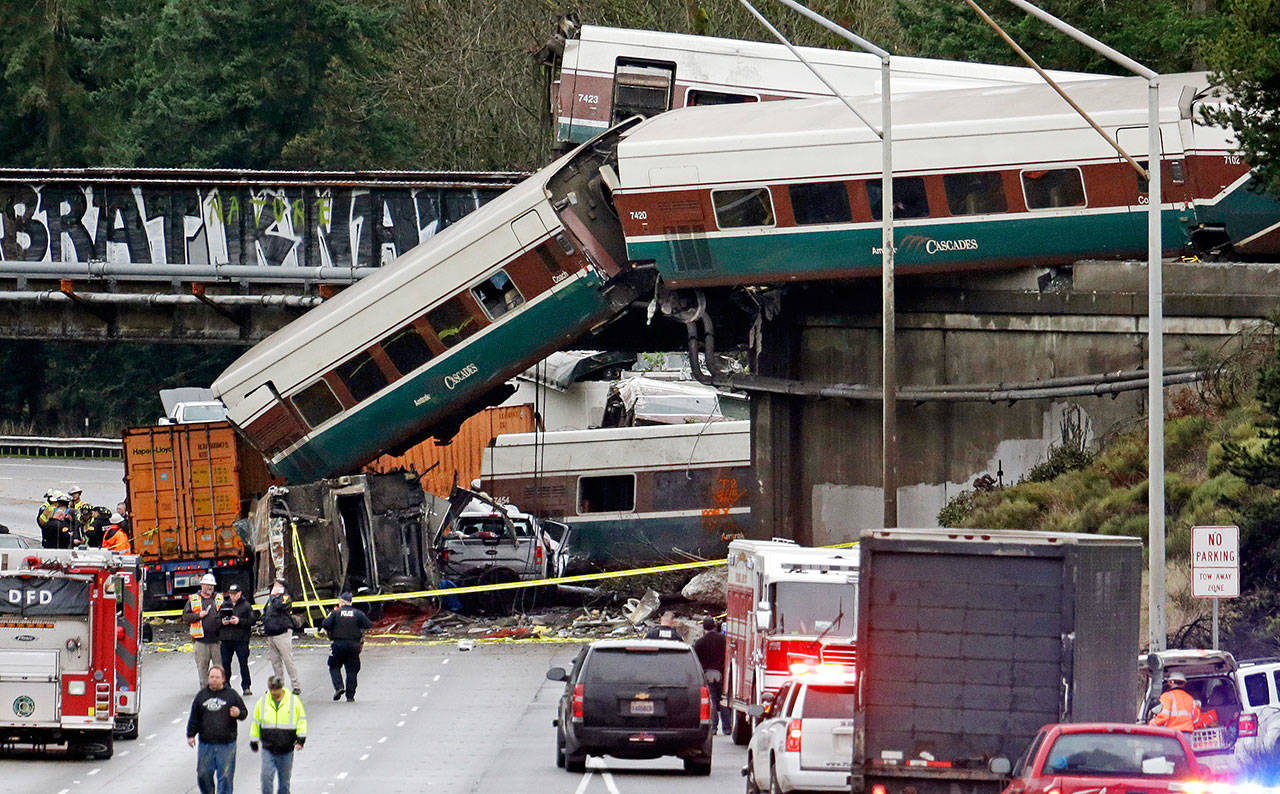By Phuong Le
The Associated Press
SEATTLE — Federal safety investigators questioned transportation officials about last year’s Amtrak train derailment south of Seattle that killed three people and injured dozens, focusing some questions on the curve where the train derailed.
The Amtrak train was recorded at 78 mph as it rounded a curve in a 30-mph zone, and plunged off a highway overpass near DuPont and onto busy Interstate 5.
The two-day investigative hearing, which began Tuesday, resumed Wednesday in Washington, D.C.
Throughout several hours, members of the National Transportation Safety Board questioned officials with the state Department of Transportation, Sound Transit, Amtrak and the Federal Railroad Administration about the deadly Dec. 18 crash.
Investigators quizzed the parties on a number of issues, including safety measures taken at that curve where the train derailed, how engineers were certified and trained on new routes, how safety was co-ordinated between so many parties and why a new safety technology known as positive traffic control wasn’t installed.
The train was on its first paid passenger run on a new route from Tacoma to Portland, Ore., part of a federally funded bypass project designed to shave time off that route.
A long, uncomfortable silence came in the final hour, when board member Earl Weener questioned the parties about who had responsibility to determine mitigation at that curve where the train derailed.
When no one answered, Weener said: “That’s what I was afraid of.”
He pressed on after more silence: “So nobody is responsible for the potential mitigation or at least the identification of the curve being as problematic as it turned out to be?”
Ron Pate, a Washington state transportation official, responded that the state contracted with an engineering company which was responsible for the design, which was given to Sound Transit. Many parties signed off on those drawings, he said, and it had to be accepted as part of contractual documents.
Sound Transit owns and maintains the tracks. Amtrak, which has a contract with the state, provides passenger train service along the route.
Michael DeCataldo, Amtrak vice-president of transportation operations, told the panel that Amtrak welcomed the opportunity to “make sure that nothing like this happens again.”
He said Amtrak has worked to address gaps that the crash revealed, including now requiring a minimum of four round-trip qualifying tests or trips before a locomotive engineer is certified for a route.
The 55-year-old engineer had operated the train twice northbound and once southbound on the new route, as well as observational trips, before the crash. He was accompanied in the cab by a conductor who was familiarizing himself with the new route.
The engineer previously told investigators he knew the curve with a 30 mph speed restriction was at milepost 19.8 and he planned to start braking about a mile before reaching it. But he said he didn’t see a marker at milepost 18 or a nearby speed warning sign.
The engineer said he applied the brake as soon as he saw a 30 mph sign at the start of the curve, but the train derailed seconds later as it entered the reduced speed zone and derailed.
NTSB chairman Robert Sumwalt brought up the issue of the curve, noting that the engineer reported that he was very aware of this curve. He asked the witnesses whether anyone was aware of issues of peripheral vision out of the locomotive. No one did.
“The odd thing is that this curve was very much on his mind and yet he still missed it,” Sumwalt said.
Asked whether WSDOT or Sound Transit ever considered delaying the run until the safety technology known as PTC was installed, officials said no. A Washington state transportation official said other routes already operating did not have such technology.

